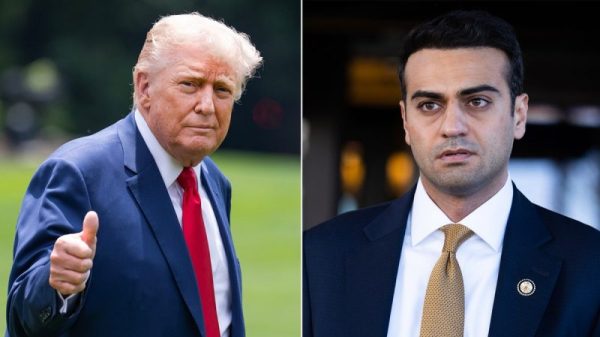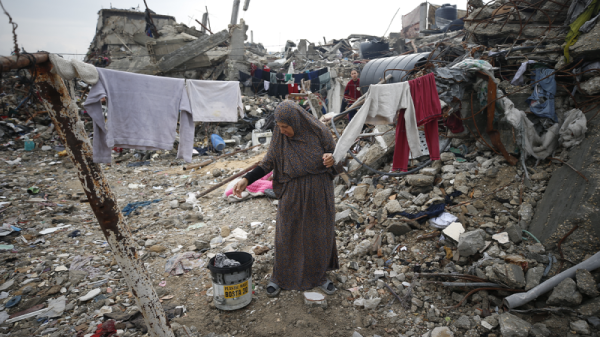Since September 1, the Ukrainian capital Kyiv has been spared from Russian drone attacks on just one night – October 14.
Every other night, many of its 4.5 million residents have been woken by sirens and rushed to some form of shelter or hidden in their bathrooms.
In the first week of November alone, sirens blared for 43 hours.
The onslaught is just one indicator of Russia’s ability to prosecute its assault at full throttle, even as Ukraine faces deep uncertainty about future support from the US and Europe.
The cities of Kharkiv, Zaporizhzhia and Odesa have also suffered frequent drone and missile strikes in recent weeks in what appears to be a renewed Russian effort to break the resolve of Ukrainian civilians.
On Saturday night, Ukrainian air defenses detected a record 145 incoming Shahed drones.
The spike in attacks on cities comes as Russian forces continue to make incremental gains in Donetsk, while Ukrainian units suffer from manpower shortages and are increasingly stretched along the vast front line.
‘Constant anxiety’
Viktoria Kovalchuk said that after debris from a drone fell close to her home last week her 6-year-old son Teo was “very scared and grabbed onto me.”
Kovalchuk said Teo was in a state of constant anxiety. “For the past two months, when the shelling has become more frequent, we have been hiding in the bathroom or going down to the shelter in the basement,” Kovalchuk said.
“I don’t remember when we had a proper night’s sleep.”
“We will restore everything on our own and continue to work as we have been doing,” he insisted.
Alarms alone are hugely disruptive to the city’s life. Bridges close, public transport is halted, and the two parts of the capital either side of the Dnipro river are effectively cut off.
Many children don’t come to school during alerts, Usov said.
Many air defense batteries are run by volunteers from all walks of life – among them one of the judges on Ukraine’s Supreme Court, Yuriy Chumak.
“We have been doing this for over two years,” he said, but the intensity of drone attacks had peaked over the past two to three months.
Their equipment is low-tech – machine-guns on the roofs of eight high-rise buildings. “Drones were flying low, (so) it was realistic and cheap to shoot them down with a machine gun.”
“At night, we are on duty continuously. There are attacks every day now,” Chumak added.
The drone attacks seem calculated to instil fear rather than cause mass casualties, but several people have been killed in recent weeks. Among them was 15-year-old Mariya Troyanivska, described by her Kyiv school as an inspiration “who loved life and gave joy to everyone around her.”
The relentless attacks do appear to be eroding morale. The Kyiv International Institute of Sociology regularly asks people whether Ukraine should continue fighting for as long as it takes. The number saying yes has fallen from 73% in February to 63% last month.
‘Difficult’ front lines
That perception is likely fed by news from the front, where Russian assaults continue to erode Ukrainian defenses, especially close to the key hub of Pokrovsk in Donetsk.
The commander in chief of the military, Oleksander Syrskyi, said Saturday that, “the situation remains difficult and tends to escalate. The enemy, taking advantage of its numerical superiority, continues to conduct offensive actions and focuses its main efforts on the Pokrovsk and Kurakhove directions.”
After a two-week trip to Ukraine last month, analyst Konrad Muzyka of Rochan Consulting said the key problem is to integrate newly mobilized troops.
Muzyka posted on X that the Ukrainian incursion into the Russian region of Kursk “has stretched the already small Ukrainian forces even further.”
The Ukrainians are using a variety of battlefield drones to inflict losses on the Russians. Syrskyi said more than 52,000 enemy targets were destroyed or damaged by drones in October alone.
But drones cannot compensate for a shortage of infantry, Muzyka reflected. Despite a law passed earlier this year to improve mobilization, “the presence of newly mobilized units/soldiers is practically imperceptible.”
“We have a situation in which the Ukrainians not only cannot keep up with replacing losses, but also lose soldiers at an increasingly rapid pace due to falling morale,” Muzyka said on X.
Russian forces have become more adept at exploiting weaker points on the front line, enabling them to eat away at Ukrainian defenses within 6 miles (10 km) of Pokrovsk.
On many other parts of the 600-mile frontline, the Ukrainians are also on the defensive, with some analysts expecting another Russian push in the south. The only gains for the Ukrainians this year have been inside Russia, where they launched a surprise incursion in the Kursk region in August.
The negative outlook has darkened the mood among Ukraine’s allies, who talk much less about Kyiv prevailing on the battlefield – and much more about it holding enough ground to force the Kremlin to negotiate.
US Defense Secretary Lloyd Austin implied as much. “No single capability will turn the tide. No one system will end Putin’s assault. What matters is the combined effects of Ukraine’s military capabilities — and staying focused on what works.”
Rym Montaz of the Carnegie Endowment for International Peace, assesses that there is a “growing, quiet consensus that negotiations, which will entail accepting at least a temporary loss of sovereignty over territories, are the only way to end this war.”
“Kyiv is at one of its weakest points since February 2022, and the prospect of selling such a negotiation is a political minefield” for Zelensky, Montaz says.
Victory, defined by the Ukrainian government as ousting Russian troops from all its territory, is widely seen as unattainable.
In a new essay in Foreign Affairs, Richard Haass says that “Washington must grapple with the grim reality of the war and come to terms with a more plausible outcome.”
“There is no game-changing weapon or lifted restriction that would allow Ukraine to simultaneously defend what it already controls and liberate what it does not,” Haas writes.
Ukrainian officials are putting a brave face on a gloomy outlook.
Foreign Minister Andrii Sybiha said Saturday: “I am convinced that we are all united by the goal of achieving a just peace for Ukraine and stopping Russian aggression … We are talking about a just peace, not appeasement.”
The path to any negotiation is – to put it mildly – unclear. The Kremlin says its goals in Ukraine are unchanged: the annexation of four eastern and southern Ukrainian regions. Russian forces already occupy almost all of Luhansk and substantial parts of Donetsk, Zaporizhzhia and Kherson – altogether some 20% of Ukraine.
“If Ukraine wants to persuade Russia to join peace talks, it must first stabilize the front and rebuild its forces enough to be able to conduct offensives,” says Muzyka.
Talk of how to end the conflict will now go into overdrive with Donald Trump’s election triumph. Trump has previously said he could end the war in 24 hours and in September he declared: “I think it’s in the US’ best interest to get this war finished and just get it done.”
One option favored by his vice president-elect, JD Vance, is to freeze the conflict on its current lines with a heavily fortified demilitarized zone to deter future Russian aggression. Along a poorly defined front line hundreds of miles long, that would be a daunting and perhaps impossible task.
It would reward the Kremlin with control of territories already seized. Moscow would also demand guarantees of Ukraine’s neutrality or at least the indefinite suspension of its drive to join NATO.
Even if on the backfoot, this would be impossible for President Volodymyr Zelensky to swallow without guarantees of Ukraine’s future security. And after the sacrifices of the past 1,000 days, it would also be unpalatable to many Ukrainians.
But the destination may be changing.







































